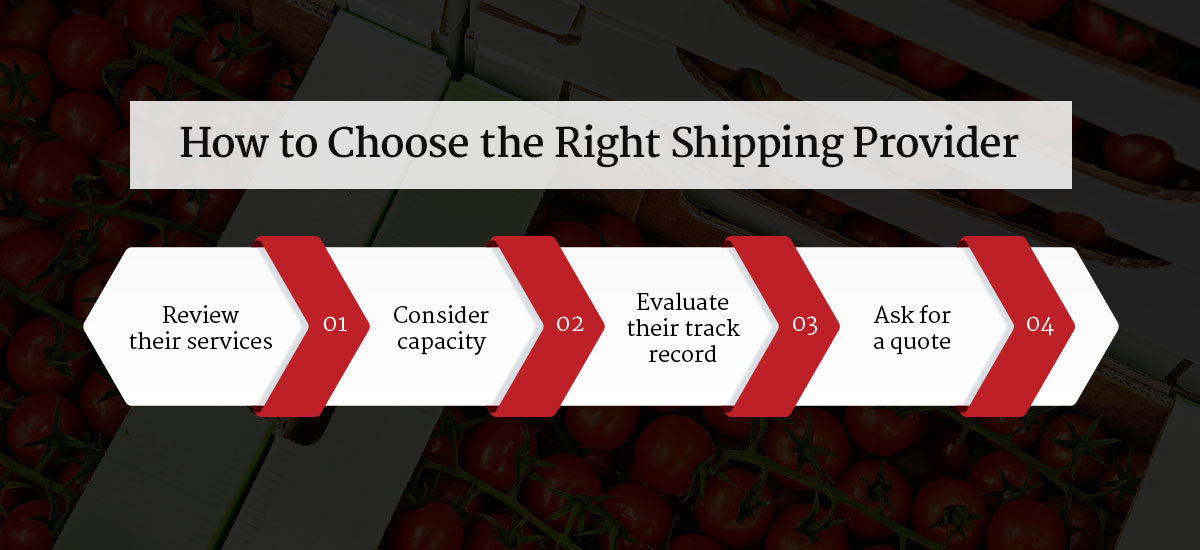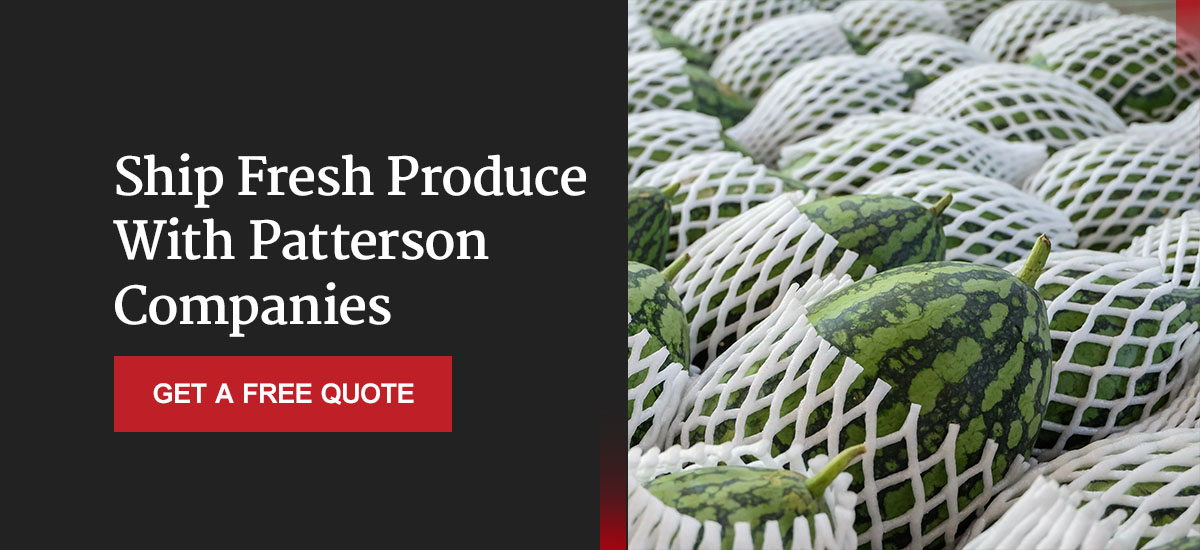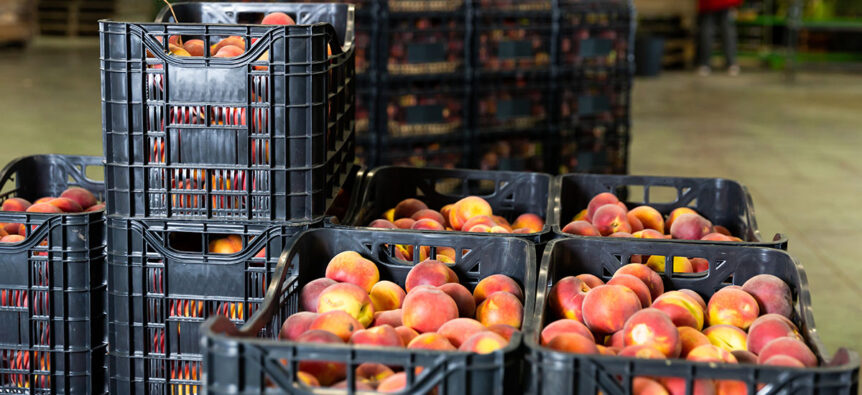Agricultural businesses invest significant time, effort and financial resources in yielding quality produce. However, once the produce leaves the farm, shippers rely on the shipping provider to ensure it remains fresh.
This step-by-step guide will explain how to ship vegetables, fruit and other produce to different states. We’ll also dive into how to select a shipping service for ultimate peace of mind.
Who Needs to Ship Produce?
Various businesses need to find a reliable way to ship produce, and they often use full truckload (FTL) shipping to move their products to grocery stores. Some other industries that ship produce include:
- Local and commercial farmers: Smaller farms will need a reliable shipment method to move produce to local markets and restaurants. Bigger agricultural businesses can make the most of FTL shipping for affordable large-quantity shipments.
- Retailers: Grocery stores and supermarkets rely on efficient produce shipments to replenish their inventory. Choosing a reliable shipping service helps keep your shelves stocked and customers happy.
- Hospitality: Caterers, hotels and restaurants need to facilitate produce shipments to ensure their chefs have the best ingredients on hand.
- Large-scale sporting events: Athletes need to fuel their bodies with fresh produce — organizers can leverage professional shipping services to optimize event catering.
- Meal subscriptions: Companies specializing in creating meal delivery kits can assemble the ingredients at their main premises and distribute them to other states using professional shipping services.
While it’s common for larger businesses to send produce to different states, individuals can also use similar services — as long as their quantities are over 150 pounds.
How Transport Works for Fresh Produce
Each step in the refrigeration process ensures overall quality. Here’s an overview of how fresh produce is handled during transit:
- Initial refrigeration: Products are kept at a constant temperature to prevent premature decay. By maintaining a constant temperature, companies help to ensure product longevity and customer peace of mind.
- Temperature monitoring: With a combination of temperature loggers and sensors, you can keep track of the product’s overall temperature.
- Loading and transport: Leveraging a skilled team ensures all produce carriers are loaded correctly. If your produce requires ventilation, you can be sure the team will achieve this goal.
How to Choose the Right Shipping Provider
Choosing an experienced shipping provider like Patterson Companies helps ensure your produce retains its quality and arrives on time. Here are some tips to assist with your selection:

- Review their services: Refrigerated, frozen and temperature-controlled products require special handling. Look for a provider that specializes in these services so there are no breaks in the cold chain. You should also look for providers that can accommodate your unique shipping requirements, such as specialized handling instructions and specific delivery times.
- Consider capacity: The volume of your produce may fluctuate, but your shipping provider should always be able to handle your freight. Your FTL shipping provider should accommodate larger shipments to keep operations efficient.
- Evaluate their track record: Customer reviews will give you a good indication of a company’s reliability. In addition, you can assess whether their customer support team is responsive and helpful.
- Ask for a quote: Requesting a free quote will allow you to compare pricing structures from multiple providers. Consider the level of service you will receive when reviewing quotes.
Patterson Companies offers customized solutions and a reliable carrier network. We can meet the most demanding standards and handle the timely delivery of your temperature-sensitive freight with ease.
Frequently Asked Questions
While our guide covers most of the details regarding how to ship fruit to another state, you may have additional queries. Review some of your frequently asked questions or get in touch with our team for more information.
How Does Produce Stay Fresh During Shipping?
Shippers can keep their produce fresh by choosing a provider specializing in moving frozen, refrigerated and temperature-controlled products. There are several steps you must take to ensure your produce retains its quality throughout transit. Here’s a brief overview of how to ship fresh produce:
- Plan the shipment: Organizing your shipment will ensure the provider can deliver your produce to its destination on your desired date. This is crucial as fresh produce has a short shelf-life.
- Check produce quality: Some produce may start to rot between harvest and shipment. Perform a visual and firmness check to ensure you get the most value from your shipment.
- Prepare the shipment: Select a sturdy box that comfortably fits the items so they remain in place during transit. Consider using ventilated bags and boxes for optimal cold chain efficiency and box fillers for additional protection.
- Ship and track: Prepare the required paperwork to ensure a seamless shipping process. In addition, shippers can track their produce throughout the journey, allowing them to keep their customers informed of its estimated arrival.
Companies that offer these services will have the required equipment to regulate their temperature during shipping. In addition, it’s essential that shippers use appropriate packaging for optimal freshness.
Are There Any Regulations for Fresh Produce Shipping?
There are strict regulations governing produce shipments. For example, the U.S. Department of Agriculture (USDA) restricts moving some fruits and vegetables to minimize contamination.
Working with an experienced shipping provider can help you understand which produce you can ship.
What Is the Best Temperature for Transporting Fresh Produce?
The ideal temperature for shipping produce will differ according to the type. Products like bananas will need slightly warmer conditions while hardy veggies like potatoes can withstand more significant temperature fluctuations.
Enquire with your shipping provider for precise temperature advice.

Ship Fresh Produce With Patterson Companies
Keeping your produce fresh during transit ensures you get the most value from your hard work. Patterson Companies has decades of experience transporting refrigerated, frozen or temperature-controlled products. We offer FTL shipments, allowing you to ship a wide range of produce at once. Get a free quote today or contact our supportive team for more information!

